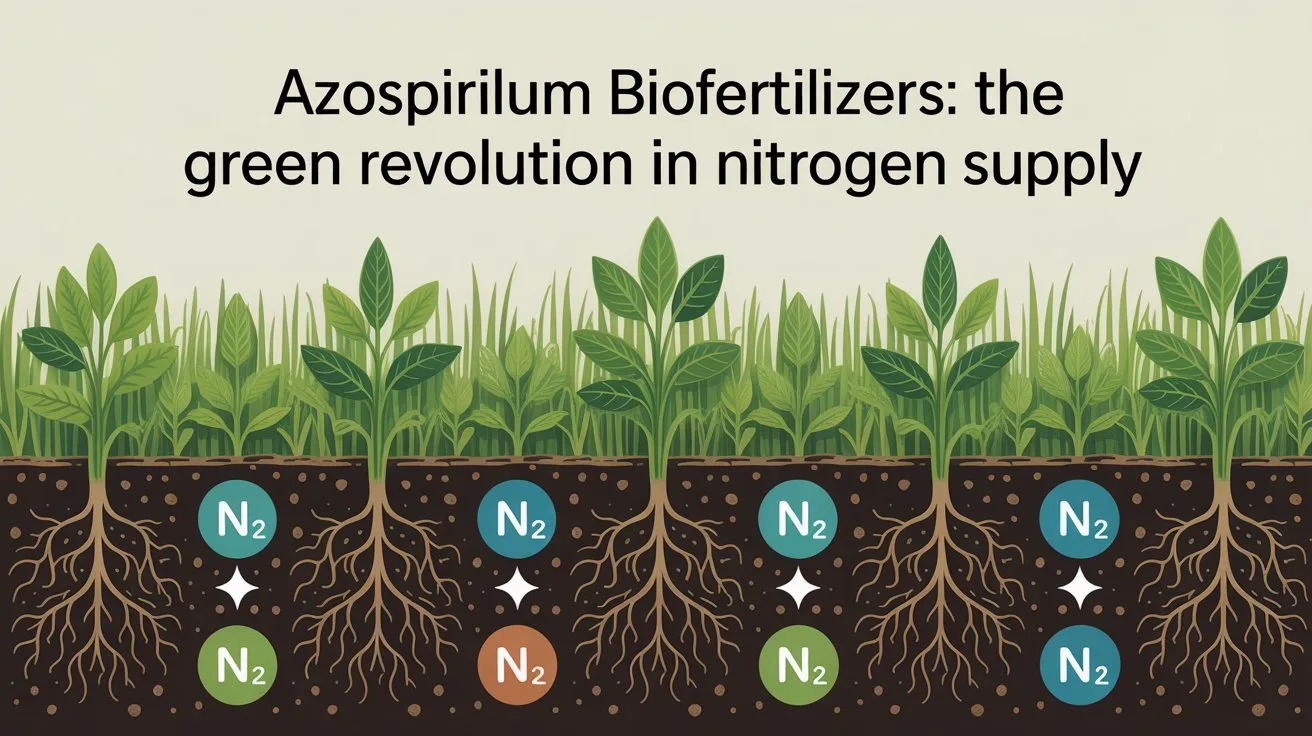Azospirillum biofertilizers are rapidly gaining appeal as a sustainable, eco-friendly way to improve soil health and increase crop yields. These biofertilizers harness the nitrogen-fixing capabilities of Azospirillum bacteria, which symbiotically uses available nitrogen from the atmosphere and makes it available to promote uptake by plants. The Azospirillum's natural process of enhancing soil fertility removes the reliance on ingoing what may eventually be synthetic chemical fertilizers while advancing bio-promoting and environmentally sustainable agriculture.
Azospirillum biofertilizers are essential for promoting plant growth, especially by fixing nitrogen in the rhizosphere, closely reducing bio-reliance in chemical nitrogen fertilizer to promote increased uptakes especially plant farmers.
Azospirillum liquid fertilizers, especially when used to application for quick colonization, particularly in liquid fertilizer formulations allow beneficial bacteria to be distributed efficiently across the soil or deposited conveniently directly on the plant roots for fast distribution results across the rhizosphere.
Introduction: Why Azospirillum Biofertilizers Are the Future of Sustainable Farming
Azospirillum biofertilizers are challenging the agriculture industry to sustainably produce a chemical fertilizer alternative in an environmentally friendly way. Bio-fertilizers usually used Azospirillum bacteria that have the natural ability to sync nitrogen from the atmosphere and make it available for plant uptake for soil to become fertile. Not only does Azospirillum biofertilizer potentially improve soil quality, but they also remove intake of unnecessary synthetic and resource-depleting fertilizers that are typically environmentally unfriendly.
Hidden Nitrogen Hunger in Global Cropping Systems
Nitrogen is an essential nutrient for plant growth, but many cropping systems around the world have nitrogen deficiencies. Synthetic nitrogen fertilizers have been a primary solution, however, they also bring significant problems of pollution, soil depletion, and greenhouse gas emissions.
Azospirillum biofertilizers provide a natural way to solve the nitrogen deficiency problem, by using the atmospheric nitrogen and making it available to plant growth. This process of biological nitrogen fixation leads to reduced hidden hunger with respect to nitrogen in the soil. By supplying an alternative to synthetic nitrogen fertilizers, Azospirillum enables crops to grow healthier and stronger (again, without the negative environmental concerns).
Azospirillum Liquid vs. Synthetic Urea—Energy and Carbon Footprints
How an Azospirillum Fertilizer Fits with Other Bio-Inoculants
Azospirillum fertilizers work together with organic bio-inoculants like phosphate-solubilizing bacteria, mycorrhizal fungi, and potassium mobilizers, to provide optimally balanced nutrition for your crop. Although Azospirillum is known as a nitrogen-fixing bio-inoculant, the other organic bio-inoculants supply different soil nutrients.
Understanding Azospirillum: The Science Behind These Nitrogen-Fixing Allies
Azospirillum bio-fertilizers represent a new era of sustainable agriculture using biofertilizer potential for fixing atmospheric nitrogen into usable-plant forms. Azospirillum is a nitrogen-fixing bacterium native to the rhizosphere, or root zone of a plant, and provides valuable nutrients to enhance soil health and crop productivity. In their biological form, Azospirillum bio-fertilizers complement the function of synthetic fertilizers and dramatically lessen environmental impacts to make agriculture more sustainable.
Biological Nitrogen Fixation in the Rhizosphere
The biological fixation of nitrogen is one of the most important uses of Azospirillum bio-fertilizers. Nitrogen is an important nutrient for plant growth; however, plants cannot absorb nitrogen from atmospheric sources. Azospirillum can fix nitrogen from the atmospheric air into a form that plants can use. for example, Azospirillum will colonize the root systems of plants and will fix atmospheric nitrogen (N2) into a form that plants can use, such as ammonium (NH4+).
Production of Growth Hormones (IAA, GA) and Root Stimulation
Apart from nitrogen fixation, Azospirillum biofertilizers also produce natural plant growth hormones, such as indole-3-acetic acid (IAA) and gibberellic acid (GA), which play an essential role in promoting plant health.
- Indole-3-Acetic Acid (IAA): This is a form of auxin, a plant hormone that stimulates cell elongation and helps roots grow faster and stronger. IAA enhances root development, enabling better absorption of water and nutrients from the soil. Stronger roots also help plants withstand environmental stresses like drought.
- Gibberellic Acid (GA): GA promotes overall plant growth by stimulating cell division and elongation, which results in improved plant height and root structure. It also encourages flowering and fruiting in plants, making Azospirillum an excellent choice for crops that require enhanced reproductive performance.
Together, these hormones provide a natural, organic way to stimulate growth, improve root systems, and increase the resilience of plants, all of which contribute to better overall plant health and crop productivity.
Compatible Crop Families—Cereals, Pulses, Oilseeds
Azospirillum biofertilizers are compatible with a wide range of crops, making them a versatile tool in sustainable farming. They are particularly beneficial for cereals, pulses, and oilseeds, as these crop families tend to benefit significantly from enhanced nitrogen availability and improved root development.
- Cereals: Crops like wheat, maize, and rice benefit from Azospirillum’s nitrogen-fixing capabilities and growth hormone production. The increased root growth helps the plants better access nutrients, leading to higher yields and improved resistance to stress conditions.
- Pulses: Beans, lentils, and chickpeas have specific nitrogen needs that can be met by Azospirillum biofertilizers. The bacteria enhance nitrogen uptake and root development, improving overall crop growth.
- Oilseeds: Crops such as soybean and sunflower also benefit from Azospirillum’s ability to fix nitrogen and improve root structure, leading to better growth and higher oil content.
Benefits of Using Azospirillum Fertilizer Over Chemical Alternatives
Azospirillum biofertilizers, including both liquid and granular forms, offer a sustainable and eco-friendly alternative to traditional chemical fertilizers. These fertilizers are rich in nitrogen-fixing bacteria that naturally enhance soil fertility and plant health, providing multiple benefits over synthetic fertilizers. The use of Azospirillum fertilizers can result in improved soil health, better crop yields, and a more sustainable farming system.
Soil Organic Matter & Microbial Diversity Gains
One of the most significant benefits of using Azospirillum fertilizer is its positive effect on soil health. Unlike chemical fertilizers, which can degrade soil health by disrupting the balance of microorganisms, Azospirillum biofertilizers promote microbial diversity and contribute to the formation of organic matter in the soil.
- Enhanced Soil Organic Matter: Azospirillum fertilizers encourage the growth of beneficial soil microbes, leading to the production of organic matter. Organic matter is essential for soil structure, water retention, and nutrient cycling. It also improves the soil's ability to absorb and store nutrients, making the soil more fertile in the long term.
- Microbial Diversity: The use of Azospirillum fertilizers fosters a rich and diverse microbial community in the soil. This diversity helps improve nutrient availability, support plant health, and protect against soil-borne diseases.
Yield, Protein, and Stress-Tolerance Improvements
The application of Azospirillum biofertilizers has been shown to improve crop yield, protein content, and stress tolerance. This is primarily due to the enhanced nitrogen fixation and the production of growth-promoting hormones by Azospirillum bacteria.
- Increased Yield: Azospirillum biofertilizers enhance nitrogen availability in the soil, which is a critical factor for plant growth and productivity. With more nitrogen, plants can produce more biomass and yield higher quantities of edible produce.
- Improved Protein Content: Crops such as legumes, cereals, and oilseeds benefit from the increased nitrogen availability provided by Azospirillum. This enhances the protein content of the crop, making it more nutritious for both human and animal consumption.
- Stress Tolerance: Azospirillum biofertilizers help plants cope better with environmental stressors like drought, high salinity, and extreme temperatures. The enhanced root development facilitated by Azospirillum bacteria enables plants to access water and nutrients more effectively, making them more resilient to stress.
Environmental Impact: N₂O Mitigation and Reduced Leaching
In addition to enhancing soil fertility and promoting plant growth, Azospirillum fertilizers offer significant environmental benefits when compared to traditional chemical fertilizers.
- N₂O Mitigation: Azospirillum biofertilizers reduce the emissions of nitrous oxide (N₂O), a potent greenhouse gas, which is often released when synthetic nitrogen fertilizers are used. By enhancing biological nitrogen fixation, Azospirillum helps maintain soil nitrogen levels while minimizing N₂O emissions.
- Reduced Leaching: One of the major environmental concerns with chemical fertilizers is nutrient leaching, particularly nitrogen, which can contaminate water supplies. Azospirillum biofertilizers, on the other hand, slowly release nitrogen into the soil, reducing the risk of leaching and improving the long-term sustainability of farming systems.
Application Techniques: How to Use Azospirillum Liquid for Maximum Impact
Azospirillum liquid biofertilizers have become a key player in modern sustainable agriculture, primarily due to their nitrogen-fixing ability, which enhances soil fertility and improves crop productivity. The correct application of Azospirillum liquid is essential to fully exploit its benefits. Different application techniques allow farmers to choose the method that best suits their crops and farming systems, ensuring optimal results.
Seed Treatment & Slurry Coating Protocols
One of the most common and effective methods of applying Azospirillum liquid is through seed treatment and slurry coating. This technique ensures that the nitrogen-fixing bacteria come into direct contact with the seed, boosting early plant growth from the start.
- Seed Treatment: Azospirillum liquid is mixed with water and used to coat seeds before planting. This method ensures that the seeds are inoculated with beneficial bacteria that will help with nitrogen fixation as soon as they germinate. The bacteria quickly colonize the root zone, making nitrogen available to the plant right from the early stages of growth.
- Slurry Coating: Another technique is the use of a slurry for coating seeds. A slurry is made by mixing Azospirillum liquid with a small amount of soil or compost. The slurry is then applied to the seed coat. This not only ensures effective inoculation but also protects the seed from early-stage pathogens.
In-Furrow Placement and Soil Drench Guidelines
For crops with more advanced growth stages or when larger quantities of bacteria are required, in-furrow placement and soil drench applications are highly effective.
- In-Furrow Placement: Azospirillum liquid is injected directly into the furrow during planting. This technique ensures that the bacteria are placed near the root zone, where they can quickly begin their nitrogen-fixing work. The close proximity to plant roots promotes rapid colonization and immediate benefits, especially for crops like corn, soybeans, and other field crops.
- Soil Drench: This method involves applying a diluted Azospirillum liquid solution directly to the soil around established plants. It is an effective way to boost soil fertility during the growing season, especially in crops that are already established. Soil drenching can be done at various stages of crop growth to support healthy root development and encourage further nitrogen fixation.
Foliar & Drip Methods for High-CFU Liquid Formulations
Foliar application and drip irrigation methods are ideal for delivering Azospirillum liquid in a more targeted manner, especially when high concentrations of CFUs (colony-forming units) are required for immediate impact.
- Foliar Application: This technique involves spraying Azospirillum liquid directly onto the leaves of plants. This method allows for the rapid absorption of the beneficial microbes, especially when the plants are under stress or experiencing nutrient deficiencies. It is an efficient way to deliver bacteria directly to the plant, as the stomata in the leaves provide an entry point for the microbes to enter the plant tissues.
- Drip Irrigation: When using drip irrigation, Azospirillum liquid is diluted and applied through the irrigation system. This method ensures that the beneficial bacteria are distributed evenly throughout the root zone, encouraging even root colonization and nitrogen fixation. Drip systems are particularly beneficial for high-value crops like tomatoes, cucumbers, and leafy greens.
Economic and Environmental Advantages of Switching Today
Switching to Azospirillum biofertilizers provides numerous economic and environmental benefits for farmers. These benefits are essential for reducing input costs, ensuring sustainability, and mitigating the impact of volatile fertilizer prices. By incorporating Azospirillum liquid and Azospirillum fertilizers into farming practices, farmers can boost yields while improving soil health and reducing dependency on synthetic chemicals. This article explores the key economic and environmental advantages of adopting Azospirillum biofertilizers.
Input-Cost Reduction and Carbon Credit Opportunities
One of the major advantages of using Azospirillum biofertilizers is the significant reduction in input costs, especially when compared to traditional synthetic fertilizers. Synthetic fertilizers, while effective in boosting short-term yields, often require large quantities of energy for production, transportation, and application. This not only raises operational costs but also contributes to greenhouse gas emissions.
- Cost Reduction: Azospirillum fertilizers help reduce the need for expensive chemical nitrogen inputs. By enhancing nitrogen fixation in the soil, Azospirillum reduces the need for synthetic fertilizers, thereby lowering input costs for farmers.
- Carbon Credits: Azospirillum biofertilizers help farmers reduce their carbon footprint by decreasing the dependency on chemical fertilizers. With an increasing global focus on sustainability, farmers using biofertilizers may also qualify for carbon credits or other financial incentives aimed at promoting eco-friendly farming practices.
Resilience to Fertilizer Price Volatility
Fertilizer prices have historically been volatile, especially for synthetic fertilizers, due to factors such as market fluctuations, geopolitical instability, and production costs. Azospirillum liquid and Azospirillum fertilizers offer a solution to this problem by reducing dependence on external synthetic fertilizers, making farms more resilient to price hikes.
- Price Volatility: By switching to Azospirillum fertilizers, farmers can mitigate the risks associated with fluctuating fertilizer prices. Biofertilizers are often more stable in terms of cost, as their production is less susceptible to external economic shocks.
- Long-Term Stability: The application of Azospirillum biofertilizers can ensure long-term soil health and fertility, reducing the need for repeated purchases of costly chemical fertilizers. This contributes to more stable farm management in the long run.
Alignment with Organic and Regenerative Standards
Azospirillum fertilizers align perfectly with organic and regenerative farming standards. These practices focus on maintaining soil health, increasing biodiversity, and minimizing the environmental impact of agriculture. As consumers demand more sustainably produced food, adopting Azospirillum biofertilizers can help farmers meet these expectations while maintaining high yields.
- Organic Farming Standards: Azospirillum liquid and Azospirillum fertilizers are compatible with organic certification, as they are made from natural microbial inoculants that promote soil health without the use of synthetic chemicals.
- Regenerative Agriculture: These biofertilizers also fit into regenerative agricultural systems, which prioritize soil regeneration, carbon sequestration, and long-term ecosystem health. By using Azospirillum biofertilizers, farmers can improve soil structure, increase microbial diversity, and reduce erosion.
FAQs
Q1. How soon will I see yield gains after applying an Azospirillum biofertilizer?
Farmers may start to notice improved growth and yield within a few weeks after applying Azospirillum biofertilizers. The nitrogen fixation process enhances soil fertility, leading to quicker plant growth and better nutrient availability.
Q2. Can Azospirillum completely replace chemical nitrogen on my farm?
Azospirillum biofertilizers can significantly reduce the need for synthetic nitrogen fertilizers, but for highly nitrogen-demanding crops, a partial application of chemical fertilizers may still be required. Over time, as soil health improves, the reliance on chemical nitrogen can decrease.
Q3. Do these strains perform well in saline or high-pH soils?
Azospirillum biofertilizers, particularly the liquid formulations, perform well in a variety of soil types, including slightly saline and high-pH soils. However, extreme conditions may reduce effectiveness, so it’s advisable to test soil conditions before use.
Q4. Is it safe to tank-mix an Azospirillum liquid with fungicides or micronutrients?
Yes, it is generally safe to tank-mix Azospirillum liquid with fungicides or micronutrients. However, always check compatibility before mixing, as certain chemicals may affect the viability of the biofertilizer.
Q5. What is the shelf life of commercial Azospirillum fertilizer products?
The shelf life of Azospirillum fertilizers varies by product, but most commercial formulations last around 6-12 months if stored correctly in a cool, dry place, away from direct sunlight. Always check the product label for specific storage instructions.
Conclusion: Embrace Azospirillum Biofertilizers for a Greener Tomorrow
Azospirillum biofertilizers represent a sustainable, eco-friendly solution for enhancing soil fertility and boosting agricultural productivity. With increasing concerns over environmental sustainability, reliance on chemical fertilizers, and soil degradation, the time to embrace Azospirillum biofertilizers has never been more critical.Azospirillum biofertilizers are a powerful tool for reducing dependence on synthetic fertilizers. By promoting natural nitrogen fixation in the soil, Azospirillum liquid ensures that plants receive the essential nutrients they need without the harmful environmental impact of traditional fertilizers. This results in healthier soils, a reduced carbon footprint, and a cleaner environment.Unlike conventional fertilizers, which often lead to soil compaction and degradation over time, Azospirillum fertilizer works by improving the biological health of the soil. It stimulates the growth of beneficial microbes and enhances nutrient cycling, leading to long-term improvements in soil fertility.




